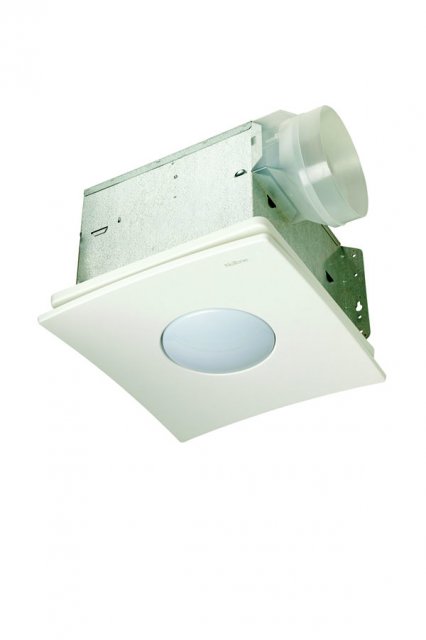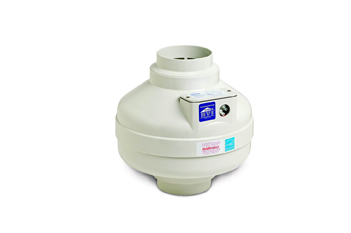ABOUT EXHAUST VENTILATION
Choose a quiet fan that’s not too powerful
Exhaust fans are rated for both the volume of air they move per unit of time (measured in cubic feet per minute or cfm) and the amount of noise they make (measured in sones, where the lower the value the quieter the fan).
An exhaust ventilation system does not need a powerful fan. According to the requirements of ASHRAE Standard 62.2, a 2,000-square-foot house with three occupants requires only 42.5 cfm of mechanical ventilation.
Oversized fans waste electrical energy and space heat. If they are very powerful, they can cause enough depressurization to make a gas water heater backdraft. Choose a right-sized fan. The lower the sone rating, the quieter the fan.
In most cases, a home equipped with an HRV or ERV does not require separate bath exhaust fans. The HRV’s exhaust air stream is drawn from bathrooms and laundry rooms.
Fans for kitchens and baths
One example of a single-port fan is the common point-of-source exhaust fan found in bathrooms to remove humidity. They are relatively inexpensive, although quieter fans cost more than noisy ones.
Unvented bathrooms that trap moisture are an invitation for mold and, in extreme cases, even structural decay. Opening a window while the shower is running is a good start, but will not reliably remove enough moisture to adequately address potential problems.
Bath and kitchen exhaust fans must be sized right. Problems can occur when a fan is too weak or too powerful.
A multi-port exhaust fan is a better option for venting large bathrooms or bathrooms with toilet or shower enclosures. This type of fan can be an inline fan mounted in the attic with a Y in the ductwork to draw from two locations or a multi-port…

This article is only available to GBA Prime Members
Sign up for a free trial and get instant access to this article as well as GBA’s complete library of premium articles and construction details.
Start Free TrialAlready a member? Log in












6 Comments
Re: RANGE-HOOD EXHAUST FANS
There is a safety issue about range hood exhaust fans that is not addressed in your article: Remote, and in-line blowers used in conjunction with a range hood fail miserably in the event of a fire on the cooking surface. The flame is pulled up through the hood and into the ductwork, quickly burning through and into wall, attic and roof.
A range hood with a squirrel cage fan mounted within the hood canopy will stop flame at the fan, giving precious seconds to fight the fire on the rangetop.
Grease fires are the most common residential fires.
If you are confronted with such a fire, do not use an extinguisher or water.
Instead, get down low and turn off the flame under the burning pot or pan.
Then grab a towel and wet it at the sink and throw it over the pan.
To see this exercise on video:
http://kitchen-exchange.blogspot.com/2009/01/this-just-in-from-my-friend-alexander.html
Exhaust Fans Accessories
Help me. Condo has no stovetop exhaust fan ventilation! Any way(s) to cope with this? Set off smoke detector in past.
Alex
Humidity Problems
Hopefully I can get myself out of this mess I got myself into :)
I recently built a pretty tight house with my old fashioned dad, I think we ended up doing a pretty good job with making the house tight, but didnt include any mechanical ventilation in the home. Right now in early october we are seeing relative humidity levels around 75% with temperatures inside of around 70 deg F.
How can I fix this? Should I install exhaust fans in the two bathrooms upstairs? My Dad says open a window, but its going to be winter very soon, and recently its been raining so much the humidity is worse outside than inside.
Im moved into the house, so any mechanical ventilation i pick im sure is going to be a disaster. The home is double 2X4 walls with a 2 inch layer of closed cell foam with 10 inches of cellulose inside of it.
Thanks in advance,
Denis
Response to Denis Recchia
Denis,
It look like you posted the same comment and questions in three different places. To avoid multiple postings, all of the answers will appear here -- on the Q&A page.
In an exhaust-only system, where does the fresh air supply from?
Just to add, this is a fantastic article. The content on this site has been very helpful and interesting. Thank You.
Also regarding fan size: I read in a book "Larger inline fans (used with a fan speed controller) can move more air, quieter."
Green,
Here is a link to an article that explains more about exhaust-only ventilation systems: "Designing a Good Ventilation System."
That article explains, "Most homes with exhaust-only ventilation systems don’t require any passive fresh air inlets in the walls. Unless the house is unusually airtight, fresh air will find its way into the home through random cracks."
Log in or become a member to post a comment.
Sign up Log in